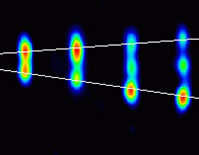Massive hole makes theories leaky

Dust and gas caught shooting away from black hole GRS1915. <br>© R.Spencer et al./Merlin <br>
Surprising black hole weigh-in has astronomers scratching their heads.
Forty thousand light years away, on the other side of the Milky Way, lies object GRS1915+105. It is a giant star and a black hole orbiting one another, blasting out X-rays and ejecting gas and dust at close to the speed of light.
Now measurements of this “extreme and puzzling” object are casting doubt on current theories of how such binary systems form and behave. Astronomers have weighed its black hole, and found it to be the most massive of its kind in our Galaxy1.
Galactic dust obscures GRS1915 from conventional optical telescopes. So Jochen Greiner and colleagues, of the Astrophysical Institute in Potsdam, Germany looked at the system in infrared wavelengths using a new 8.2-metre telescope at the European Southern Observatory in Chile.
Working out the star’s mass and orbit, they inferred a surprising mass for the black hole. It weighs about 14 times as much as our Sun. That’s nearly twice as much as any other in a similar binary system. (Black holes at the centres of galaxies can be thousands of times heavier still).
A mass of this magnitude challenges the theory that binary black holes arise when exploding stars collapse in on themselves. “It’s almost impossible to form a black hole this massive in a binary system,” says astronomer Robert Hynes of the University of Southampton, UK.
The theoretical headaches don’t stop there. The disk of matter surrounding the black hole, flowing in from its companion star, is unusually hot. To explain this, some have suggested that the hole is spinning, allowing matter to approach and heat up before vanishing into it. The death throes of this matter make GRS1915 the brightest X-ray source in the Galaxy.
But a spinning black hole of this mass creates a theoretical logjam with suggested explanations for the pattern of X-ray blasts. “If a spinning hole explains the temperature, then the [X-ray] theories are wrong, or vice versa,” says Greiner.
The discovery of similar objects not currently emitting X-rays may help to fill the gaps in our understanding, suggests Alberto Castro-Tirado, of the Astrophysical Institute of Andalucia. Castro-Tiroda was a member of the team that discovered GRS1915. “There are probably other objects like this, but they remain in a state of hibernation”, he says.
References
- Greiner, J., Cuby, J. G. & McCaughrean, M. J. An unusually massive stellar black hole in the Galaxy. Nature, 414, 522 – 525, (2001).
Media Contact
More Information:
http://www.nature.com/nsu/011129/011129-13.htmlAll latest news from the category: Information Technology
Here you can find a summary of innovations in the fields of information and data processing and up-to-date developments on IT equipment and hardware.
This area covers topics such as IT services, IT architectures, IT management and telecommunications.
Newest articles

Innovative 3D printed scaffolds offer new hope for bone healing
Researchers at the Institute for Bioengineering of Catalonia have developed novel 3D printed PLA-CaP scaffolds that promote blood vessel formation, ensuring better healing and regeneration of bone tissue. Bone is…

The surprising role of gut infection in Alzheimer’s disease
ASU- and Banner Alzheimer’s Institute-led study implicates link between a common virus and the disease, which travels from the gut to the brain and may be a target for antiviral…

Molecular gardening: New enzymes discovered for protein modification pruning
How deubiquitinases USP53 and USP54 cleave long polyubiquitin chains and how the former is linked to liver disease in children. Deubiquitinases (DUBs) are enzymes used by cells to trim protein…



